I feel like I need to give Samsung’s Galaxy S20 Ultra two scores. If I’m reviewing it solely on the merits of its components and what it can do, it’s easily a five-star device, with only the smallest of perceptible flaws.
The 6.9-inch display is remarkably bright and incredibly smooth when the 120Hz refresh rate is switched on, and the 40MP hole-punch selfie camera is much more discreet than it was on the S10. The RAM, storage, and processor are all the fastest you can get in a smartphone, and the 5,000mAh battery both lasts all day and fills up incredibly quickly. And yes, the 100X Space Zoom camera is cooler than any other telephoto lens I’ve used.
 Christopher Hebert/IDG
Christopher Hebert/IDG
You won't find the S20 Ultra name anywhere on the phone, but everyone will know what it is.
But if I were to score the Galaxy S20 Ultra on usability and cost, I’d give it closer to 2 stars (hence the 3.5-star final score). Even if it didn’t start at $1,400, a price high enough to make Apple blush—and our review model is the $1,600 step-up—the Galaxy S20 Ultra would still be far too much phone for most people. Everything feels extreme, especially its size. Samsung's push to make the ultimate device has created a gorgeous and awe-inspiring superphone that is far beyond what most people need. Or even want. (Curious about the lower-cost S20 models? Check out our comparison of the Samsung Galaxy S20 vs. the S20+.)
Big, heavy, and awkward
For several generations now, Samsung has established that its “plus” phones are essentially larger versions of base models with better cameras. On paper, that’s true of the S20 Ultra as well, but in reality, it’s much more than a super-sized Galaxy S20+.
I don’t usually spend much time thinking about the weight of my phone, but it’s hard to ignore the S20 Ultra’s mass. At 222 grams, it’s significantly heavier than S20+ (188g) and the S10 5G (198g). It’s actually a bit lighter than the iPhone 11 Pro Max, which clocks in at 226 grams, but you wouldn’t know it from holding it. With such a massive camera bump in the top left corner, the S20 Ultra is both top-heavy and side-heavy, so it requires a slightly different grip, lest it slide and slip out of your hands.
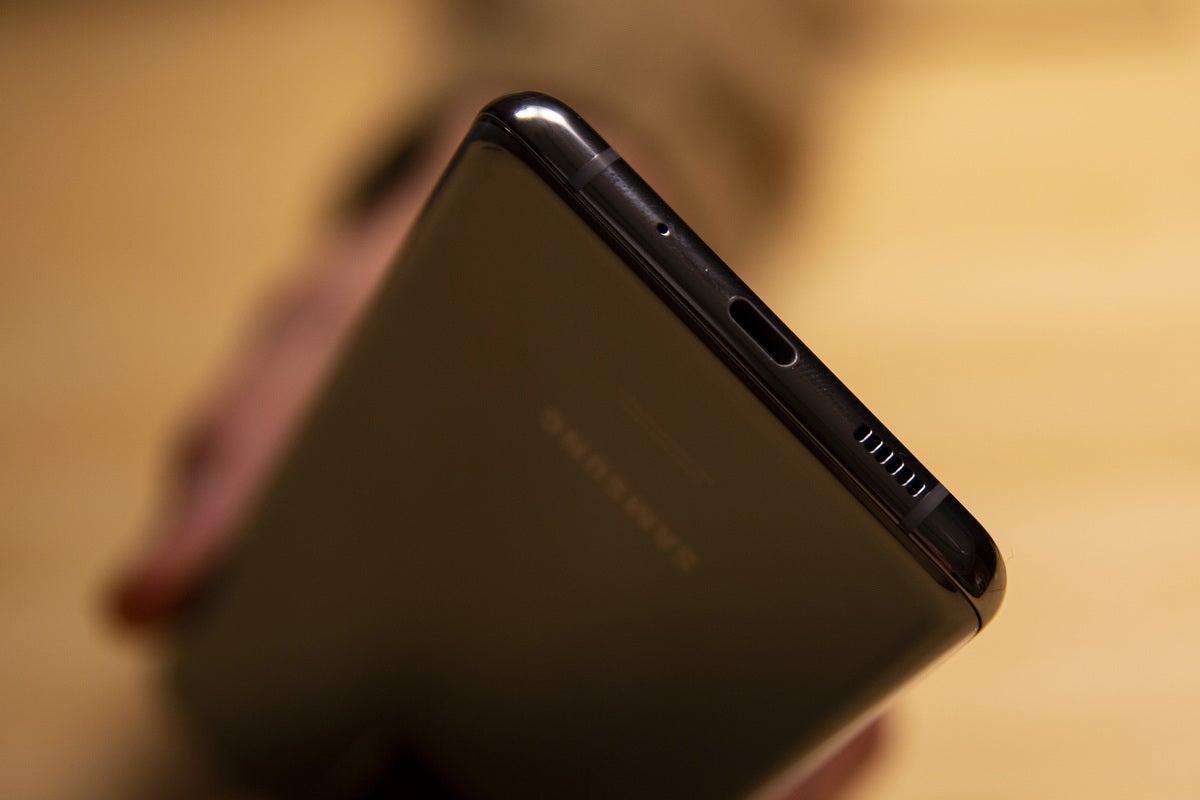 Christopher Hebert/IDG
Christopher Hebert/IDG
The S20 Ultra's USB-C port is finally perfectly centered on the bottom edge.
You can forget about one-handed operation. While the new, higher placement of the in-display fingerprint sensor has drastically improved the accuracy and reliability of the scanner when picking it up and unlocking with my thumb, the size of the S20 Ultra makes it difficult to do much else without using all 10 of my fingers. It was hard enough to use the 6.8-inch display on the Note 10+, but the S20 Ultra’s 6.9-inch screen, coupled with the weight and near-9mm thickness, is simply too much for one hand to bear.
The S20 Ultra is the only phone I’ve used that I could actually feel sliding down my hand as I held it. It’s a weird phenomenon, caused by a combination of the size, weight, and polished aluminum edges. Eventually, I settled on a grip that either contorted my pinkie finger under the bottom or used my off-hand thumb to keep it steady. I still had to adjust my grip every so often. Long stretches with the Ultra were downright uncomfortable.
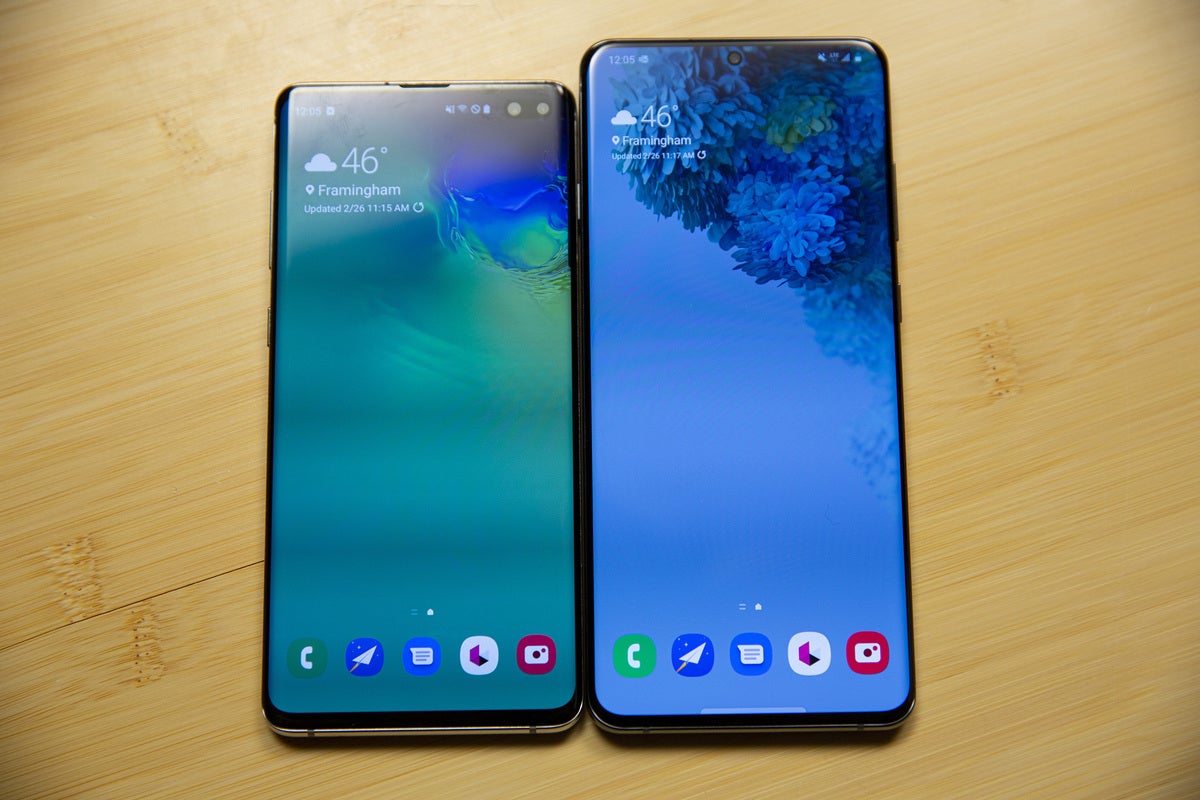 Christopher Hebert/IDG
Christopher Hebert/IDG
The S20 Ultra absolutely towers over the Galaxy S10+, which isn't exactly small.
Even if you have fingers long enough to comfortably reach the upper corners of the screen, the bulbous camera will complicate your grip. While giant geometrical camera arrays are all the rage, the S20 Ultra takes it to almost comical proportions, with a bump that protrudes some three millimeters from the back. Because it’s such a broad bump, taking up about an eighth of the rear case, your fingers will inevitably butt into it.
The giant camera bump also makes it tricky to use on a table, especially when tapping the upper left side of the screen. It’s wobblier than the S10 and the Pixel, and when a notification comes in, the haptic vibration is downright startling. All said, it’s the first phone I wanted to put in a case, which is a shame, because the glass repels fingerprints surprisingly well.
Elsewhere, it's easier to raise the volume, as the rocker has been moved to the right side above the power button. That leaves the left side completely smooth, because Samsung has dumped the Bixby button once and for all.
Gone, too, is the headphone jack, which we expected after the Note 10+ dropped the port last year. Samsung is offering a pair of USB-C earbuds in the box and selling a set of Bluetooth Galaxy Buds+ earbuds for $150. It’s still a bummer that Samsung couldn’t find 3.5 millimeters of free space on a phone this big.
Pixel perfection
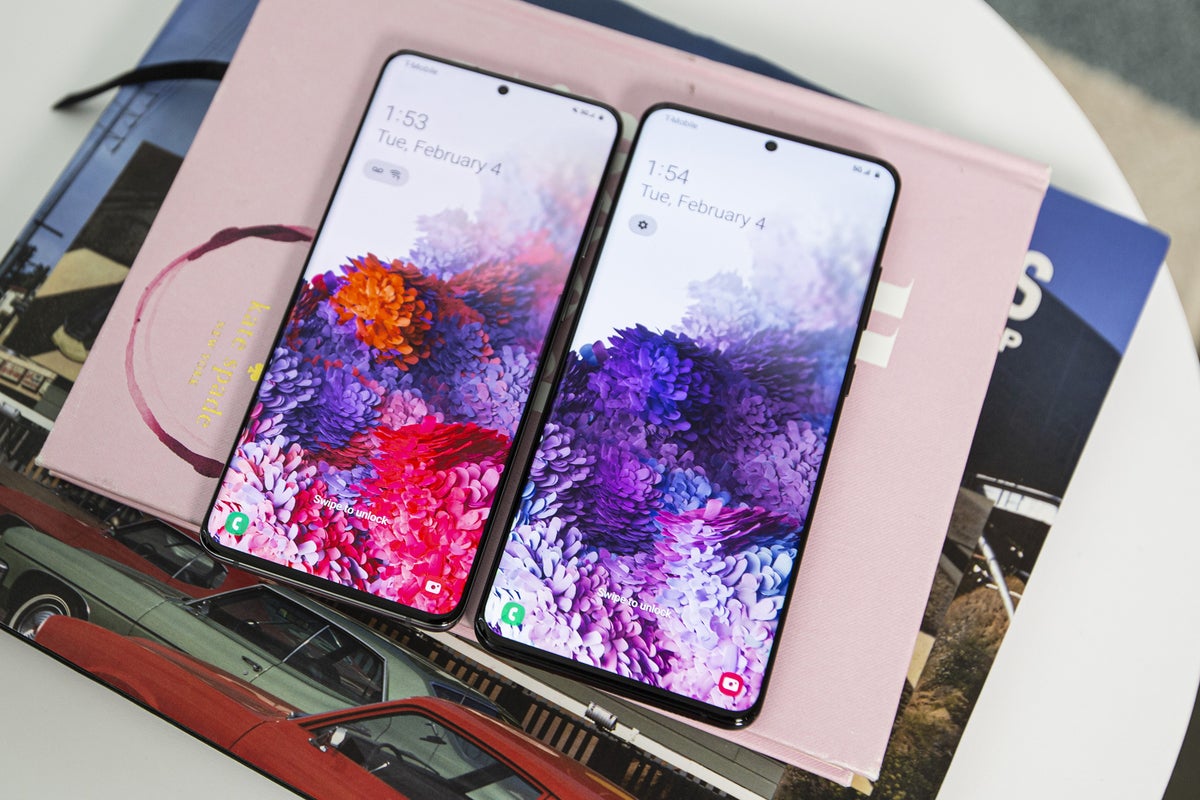 Christopher Hebert/iDG
Christopher Hebert/iDG
The front camera in the S20 line has moved to the middle of the top of the screen, a positive change from the awkwardly off-center hole of the prior generation. (As shown in the S20 and S20+, above)
Samsung has delivered its most impressive display yet for the S20 product line—and that’s before you even touch it. The weirdly off-center camera cutout of the S10 product line has been repositioned in the S20 so it’s smack-dab in the center of the top of the screen. While the hole is still a little too low to center itself inside the status bar, its new position still improves the look of the phone.
I can’t really find a fault with the image quality. It’s impressively crisp at 1440p and still very nice at the default 1080p resolution. I was able to crank it all the way up to 650 nits' brightness manually, and it reached an eye-piercing 1,350 nits with auto-brightness enabled. Its ability to transition automatically between low and bright light is excellent. Colors are vivid without being too saturated, whites are natural, blacks are impressively deep, and the whole palette is rich and robust. There just aren’t enough superlatives for how incredible the S20’s display is.
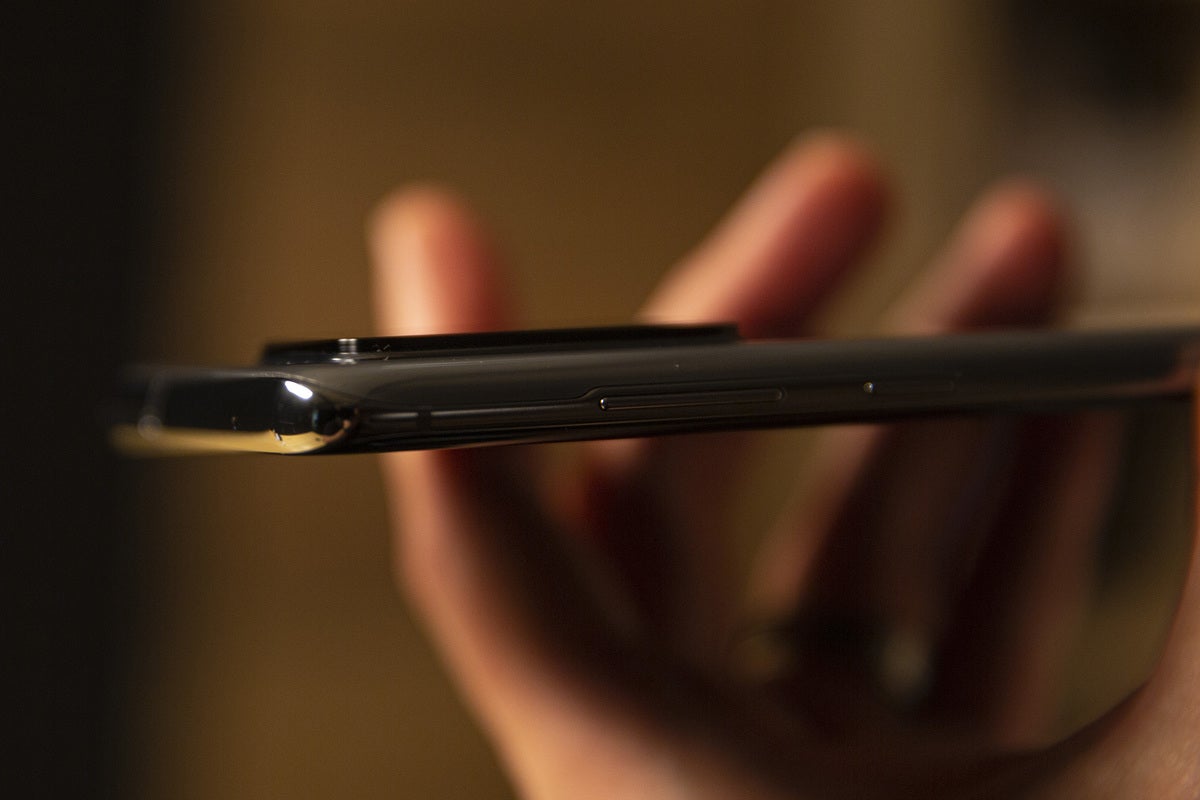 Christopher Hebert/IDG
Christopher Hebert/IDG
That's no moon, that's the 100X Space Zoom camera bump.
It’s also not quite as curved as previous Infinity displays. It’s hard to see without putting it next to a Note 10 or S10, but the S20 screen is decidedly “flatter” than those of previous generations (though definitely more curved than the S10e's). That’s a good thing: It helps cut down on accidental palm touches and still does well to hide the side bezels. I vastly prefer it to the extreme “waterfall” displays that Oppo and Vivo are pushing.
Samsung has once again gone with an ultrasonic in-display fingerprint sensor on the S20 family. While a thousand-dollar-plus phone should really have 3D facial recognition, this implementation of the fingerprint sensor is much improved over what we had with the S10. The position of the scanner is higher on the screen and the target is a bit bigger, so I didn’t need to alter my grip or flex my thumb to hit it. It’s still not quite as consistently fast as the hardware sensor on the S9 and probably never will be, but it’s plenty accurate and reliable now.
The best feature on the S20 display is actually switched off by default (and I’m not talking about the usual WQHD 1440p resolution). The S20 is Samsung’s first product line to feature a high-refresh display, and it’s gone for the gusto, opting for a full 120Hz, twice as fast as the standard 60Hz. It’s glorious. Compared to the standard 60Hz setting, scrolling, animation, and gaming are fantastically smooth, well worth the serious hit to battery life when it’s switched on.
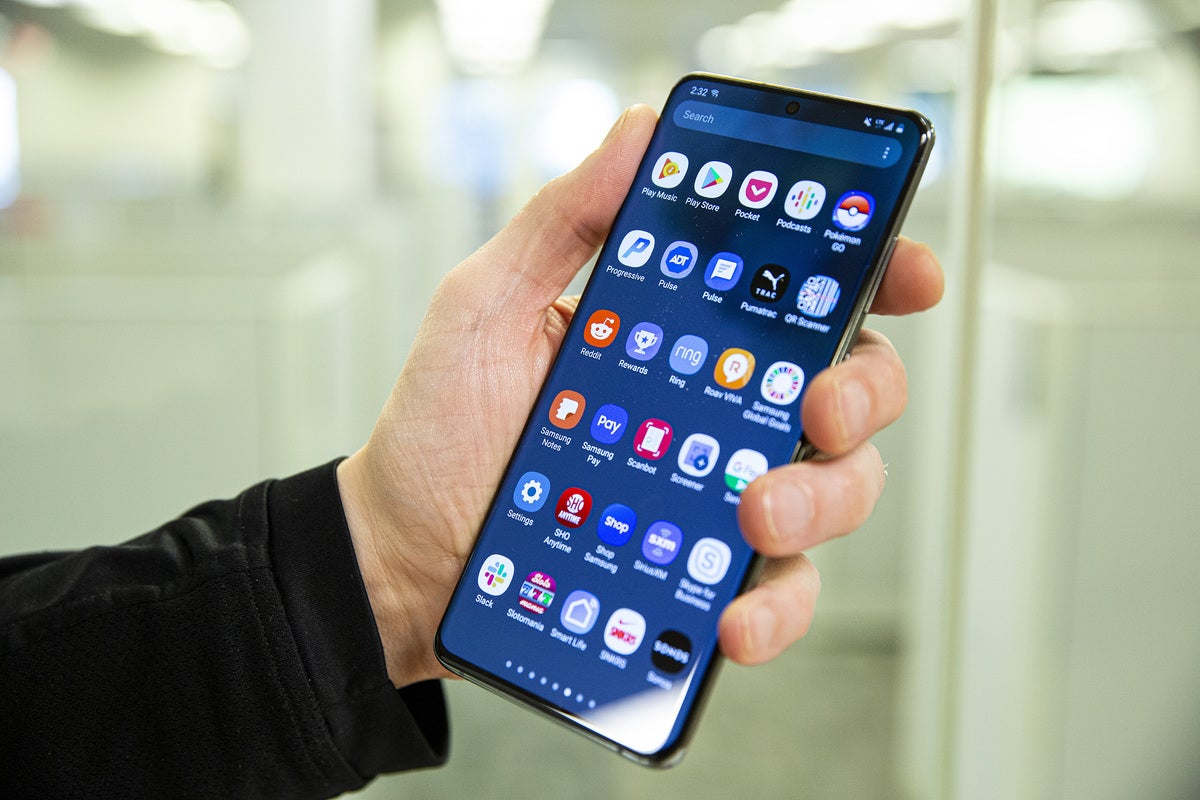 Christopher Hebert/IDG
Christopher Hebert/IDG
You can fit an awful lot of app icons on the Galaxy S20 Ultra's screen.
When pitted against the Pixel 4’s 90Hz Smooth Display, however, the difference is not nearly as obvious. Samsung could easily have gotten away with 90Hz, saved some battery life, and offered it for 1440p resolution as well, but as it stands the 120Hz setting is available only with Full HD 1080p resolution. Fast refresh with WQHD would have been nice, especially on a screen this size—I’m holding out hope that Samsung will unlock it with a future update. Despite that limitation, however, the 120Hz screen is one of the best reasons to buy any S20 phone.
Speed to spare
Galaxy phones have been fast enough since the Snapdragon 820 processor in the Galaxy S7, but the Snapdragon 865 in the S20 line is on another level. Snapdragon 855 Plus-powered phones had already broken the 10,000 threshold on the PCMark Work 2.0 benchmark, the S20 crushes expectations with a score of 12,350.
While the speed boost is palpable, Qualcomm doesn’t deserve all of the credit. Samsung is using entirely new RAM modules inside the S20, and every handset is packed with at least 12GB of LPDDR5 memory. Plus you’re able to keep three apps open for faster switching, so launching games with lengthy startup times are lightning-quick. To give you an idea of how it feels to have this much RAM: I stopped counting the apps on my Recents screen at 50.
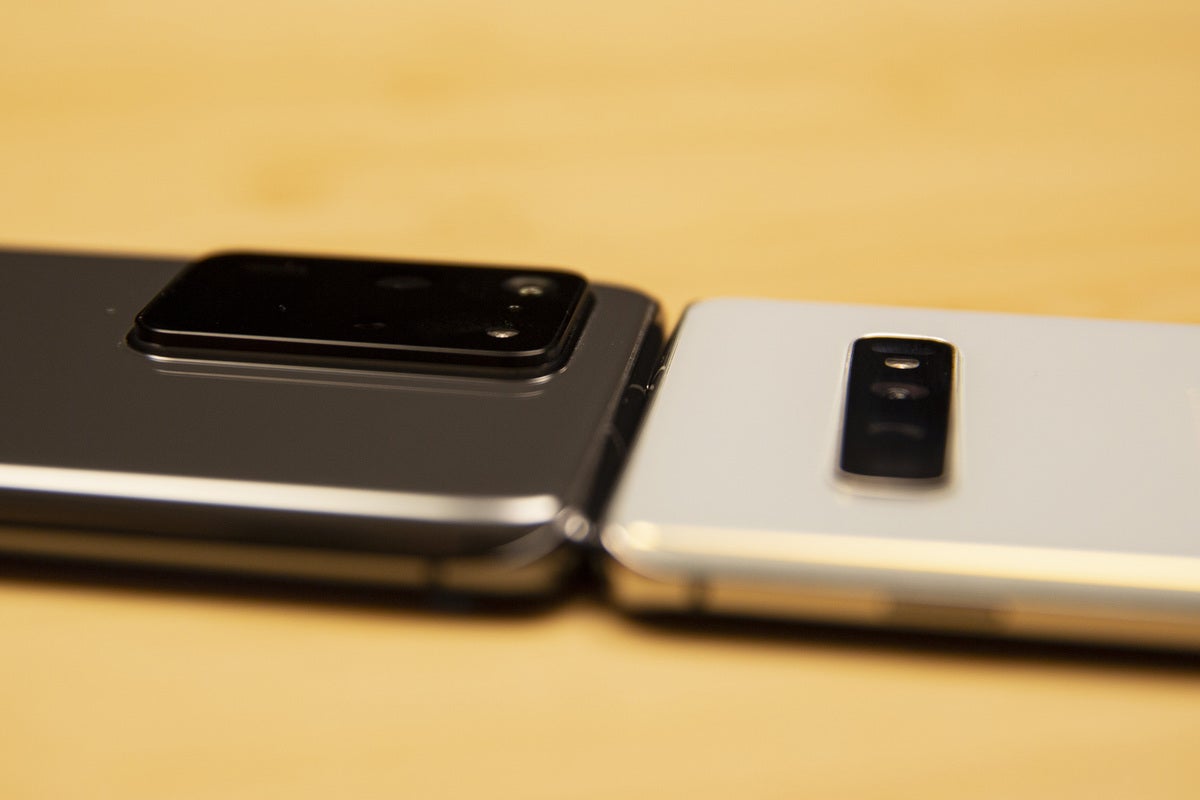 Christopher Hebert/IDG
Christopher Hebert/IDG
Compared to the S10, the Ultra's camera is a monster.
Even the SSD has improved. It’s not just the 128GB capacity—once again, twice as much as the Pixel and iPhone—but the speed: Samsung is using UFS 3.0 storage on all S20 models. While it’s not quite as fast as the UFS 3.1 storage that will probably debut in the Note 20, it’s a huge jump over what you got with the S10, and it even bests other UFS 3.0 phones (though I’m not sure what’s going on with random write results):
S20 (UFS 3.0)
Sequential read: 1,592.46 MBps
Sequential write: 662.75 MBps
Random read: 45,172.27 IOPS
Random write: 33,764.08 IOPS
S10 (UFS 2.1)
Sequential read: 802.13 MBps
Sequential write: 188.34 MBps
Random read: 34,612.61 IOPS
Random write: 7,383.57 IOPS
OnePlus 7T (UFS 3.0)
Sequential read: 1,436.19 MBps
Sequential write: 210.4 MBps
Random read: 44,158.73 IOPS
Random write: 7,189 IOPS
Add up the chip, RAM, and storage, and you’ve got a downright monster of a phone that's faster than most Chromebooks and can even give some PCs a run for their money. It’s so powerful, Samsung could probably rest on its laurels for the next two generations and still keep pace with its competitors.
Keep reading to see how that huge battery does in our tests, and more.
"much" - Google News
March 06, 2020 at 06:00PM
https://ift.tt/38tHesf
Samsung Galaxy S20 Ultra review: Too much more for most - PCWorld
"much" - Google News
https://ift.tt/37eLLij
Shoes Man Tutorial
Pos News Update
Meme Update
Korean Entertainment News
Japan News Update
Bagikan Berita Ini















0 Response to "Samsung Galaxy S20 Ultra review: Too much more for most - PCWorld"
Post a Comment